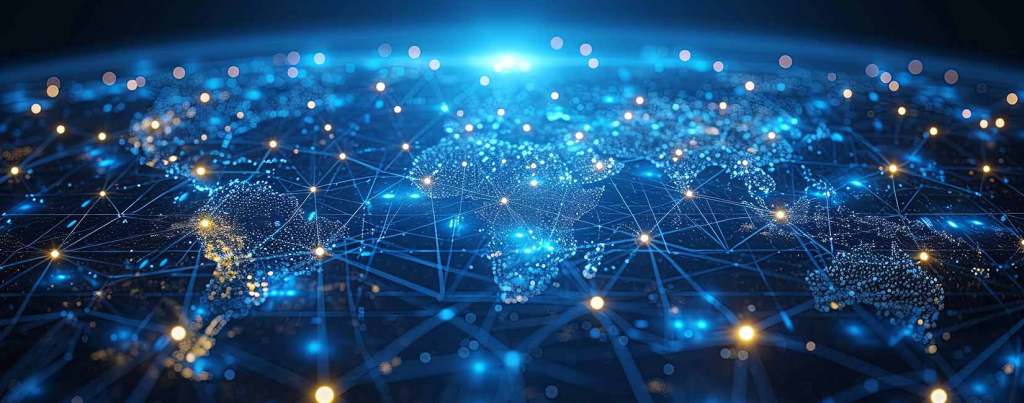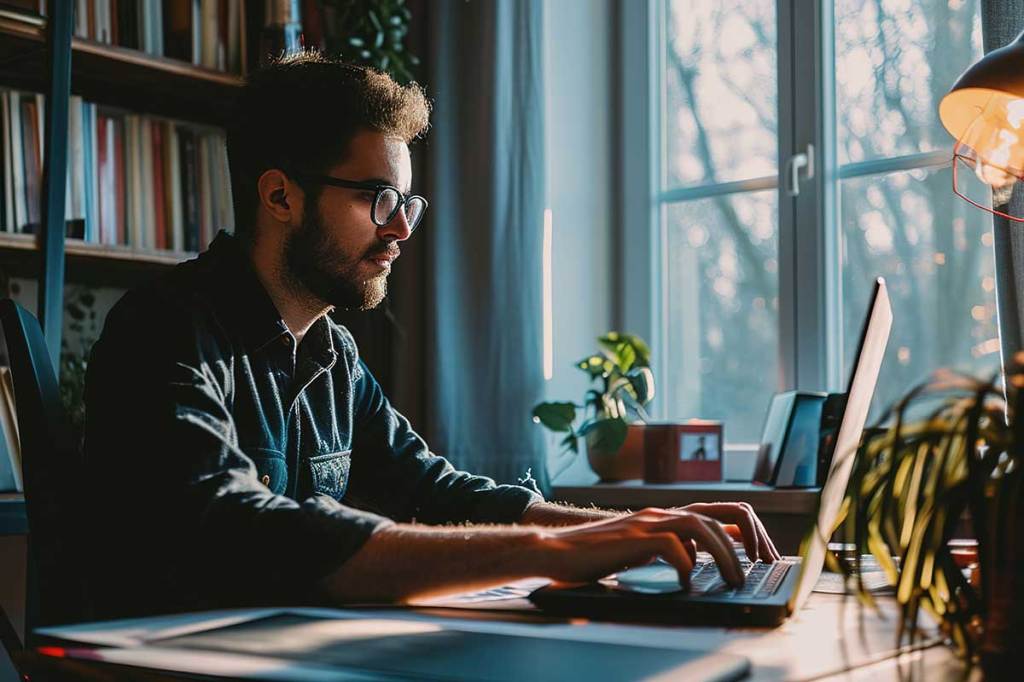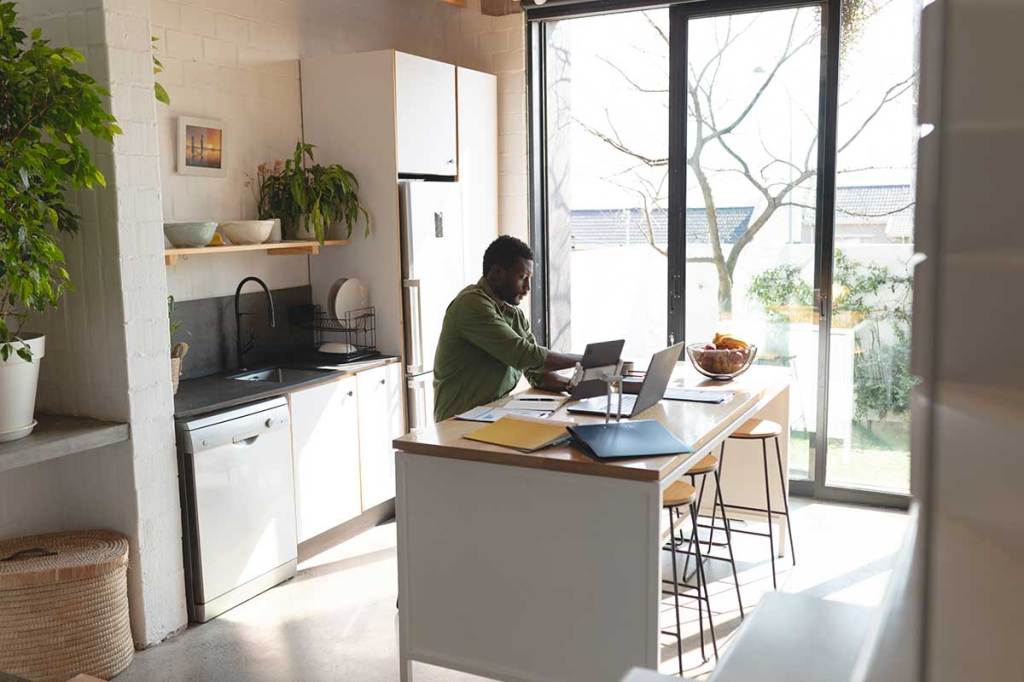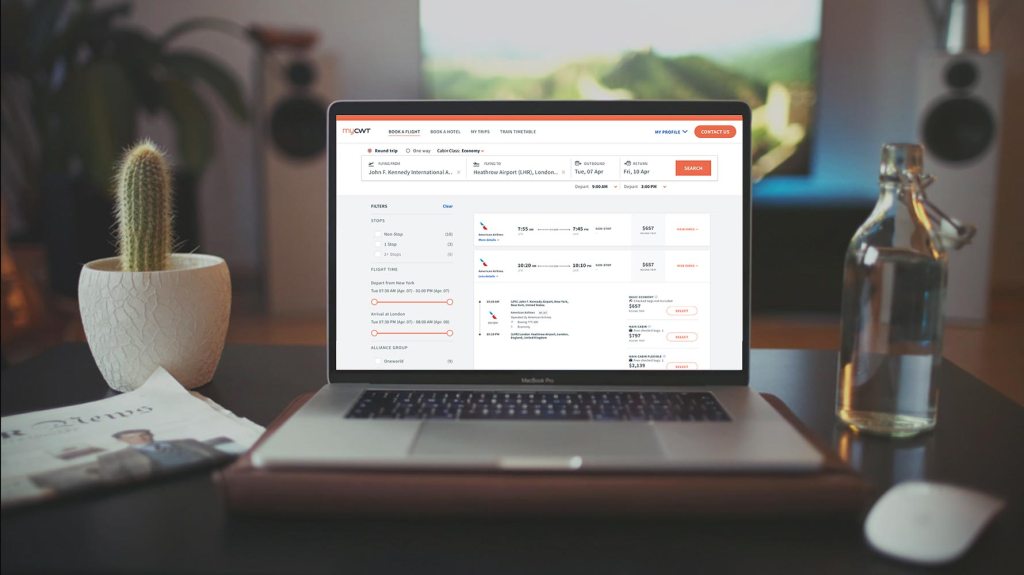Introducing the latest myCWT product and service enhancements
Building on our digital, omnichannel myCWT platform, our new products and services will simplify travel management for you and your employees – anytime, anywhere, anyhow.
Note: Featured services may not be available in your country at this time. Please reach out to your CWT representative for more details.
Hear from Chief Product Officer, Erica Antony as she shares the key product highlights of 2024, along with the key areas driving innovation.
-

2040: Baseline, Boom or Bust
As we enter an era of rapid transformation and unprecedented challenges, it is essential for travel managers, meeting & event planners, and corporate decision-makers to look ahead and frame our current strategic thinking with a clear vision of the future. Business travel and meetings and events (M&E) are poised for significant change over the next decade and a half, driven by a complex interplay of sustainability goals, technological advancements, evolving work models, and geopolitical dynamics.
In this paper to mark the 10th anniversary of our Global Business Travel Forecast, we explore, for the first time, a long-term vision of the future and potential trajectories through three distinct scenarios, each offering insights into how these forces should affect policy-making, budgeting and priorities. By examining these scenarios, we can better understand the diverse possibilities that lie ahead and the strategic imperatives required to thrive in each potential future.
Based on trajectory data analysis and interviews with industry leaders, behaviorists and climate tech founders, this forward-looking approach enables us to anticipate changes, strengthen our strategies, and make informed decisions that align long-term objectives. It is through this lens of foresight and adaptability that we can build resilience, seize opportunities, and navigate the complexities of the future.
We invite you to reflect on the insights presented, and consider how your organization can prepare for the opportunities and challenges that lie ahead. Together we can ensure that travel and meetings remain catalysts for growth, scalability and sustainable practices.
- Scenario development is both an art and a science
- Megatrends Shaping the Future of Business Travel, Meetings and Events
- Sustainability goals the new crux of corporate policy
- Technology Revolutionizes Travel Management
- Modern work models spark new travel patterns
- Changing demographics open doors to new opportunities
- Three Scenarios: Base case, boom and bust
- Future-proofing strategies

-

CWT GBTA Global business travel forecast 2025
When it comes to pricing, global business travel has finally reached an enduring, higher baseline. Prices will continue to rise in 2025, but only moderately, so expect a period of normalized growth.
However, this pricing environment, one of marginal gains and price regularity, is fragile. Global leisure travel has now realized a lot of its pent-up demand, while corporate travel has been resurgent, with 2024 edging at preCovid levels.
There are many factors at play, whether its volatile oil prices, labor costs and constraints, inflationary pressures, and geopolitical factors. As this elevated baseline edges upwards, albeit marginally, travel budgets will come under increased scrutiny, especially as travel patterns and attitudes change.
It’s why business travel can’t be viewed in a silo, and the true value to an organization must be fully realized. This forecast can help with those calculations.

-

Capitalize on emerging technologies in corporate travel
Technological advancements are accelerating at an unprecedented pace. How will emerging innovations like Generative AI, blockchain, and self-sovereign identity (SSI) transform corporate travel?
BTN and CWT probed global CEOs, travel managers, industry consultants and tech experts on the promises, questions, and expectations these innovations raise and how they are set to reshape traveler experience, cost control and service delivery in corporate travel and events.
Download and discover
- The technologies that will have the greatest impact on corporate travel in the next 2-5 years
- How these emerging technologies are poised to control costs, enhance service and security, and boost efficiency
- The critical challenges, opportunities, risks and roadblocks each innovation raises
- What travel managers, buyers and experts anticipate from these innovations

-

The Catalyst: How innovation prevails in times of crisis
There’s no rule book for pivoting a business during a global pandemic, but when it comes to innovation, necessity is the mother of invention.
Deep challenges in the economy, for business models and customers, can become drivers of innovation and when their back is against the wall, winning companies can turn a crisis into a catalyst for innovation by addressing issues in ways never thought of before.
Ensure connectivity
Ensure that your technology and people are in place, ready to take on new ways of working. For us, that meant making sure our employees had a safe place to work and the tools to service our customers.
To help travel counselors use their home phones to take calls, we extended a system built to meet the varying needs of contact center agents. We established gateways that allowed more than 1,600 employees access to their office desktop securely and supported a significant increase in concurrent VPN connectivity. In less than four weeks, we sent virtually everybody to work from home, from 132 office locations. Preparedness is key.
Cultivate a supportive culture
In the midst of a severe event, people are driven by finding solutions for their peers. Smart problem solving comes from caring for each other, and making sure that culture drives how we treat our customers. Knowing their co-workers were in remote or home locations and with fewer phone lines, our Global Service Desk launched a global chat option to answer our team members’ questions, which is now accounting for over 20% of the volume. Technology can bring people together, only on the foundation of a caring culture.
Use a crisis framework for long-term innovation
There’s no shortage of real business problems now. A crisis is an opportunity to make changes that reinvigorate employees, reinvent how we do things and learn what’s important, from a tech and business standpoint, beyond our current challenges. Pick up the best of what’s working and run with it. You might build something quickly and use the tech framework to build out a long-term solution.
In this pandemic, a common denominator is the efficiency and integrity of technology.
Stretching around the world, technology can be at the core of how companies, employees and customers all come together, both now and for the long term.
Our leadership has created a series of blogs to share their insights into the impact, recovery and opportunities for our industry resulting from this crisis – ranging from creating the business travel environment of the future to shifting meetings & events strategies to successful virtual alternatives.
Image credits: Adobe Stock
-

Executive Leadership Team Changes
CWT, the B2B4E travel management platform, today announces the following changes within its Executive Leadership Team (ELT) – Michelle McKinney Frymire is named Chief Finance & Strategy Officer, and Patrick Andersen is named Chief Commercial Officer and President of RoomIt. The changes are prompted by the planned departure from the company of David Falter, formerly President of RoomIt by CWT, all three effective 1 May 2020.
Commenting on the changes, Kurt Ekert, CWT’s President & CEO said: “By combining the Commercial and RoomIt teams we have created a more practical approach to managing these two complementary functions, and in the new operating environment it is logical to bring together strategy and finance. Michelle and Patrick’s proven track records give me great confidence in their ability to lead these teams and enhance their remits. I thank Dave for the great work he has done in growing RoomIt to its market leadership position, and we all wish him well in his future endeavors.”
Michelle Frymire was appointed to the ELT in January 2019 upon joining the company and was formerly the company’s Chief Financial Officer. She has 18 years’ travel industry experience, with CFO roles at Starwood Vacation Ownership and Delta Technology (a division of Delta Airlines), and financial leadership roles with Continental Air Lines and Delta Air Lines. In addition, she held CFO positions at several private equity portfolio companies before joining CWT. Michelle has served as a member of the Texas Women’s Foundation Economic Leadership Council and is currently on the Board of Directors for Family Gateway in Dallas, Texas. She holds a bachelor’s degree, in economics, from Austin College, Texas and an MBA, in finance and accounting, from the McCombs School of Business at The University of Texas.
Patrick Andersen was appointed to the ELT in October 2013 and was formerly the company’s Chief Strategy and Commerce Officer. He joined CWT in 2008 and has over 30 years’ experience in global travel & logistics, with various international leadership roles at Deutsche Post Worldwide and DHL. Patrick also serves as a Non-Executive Member of the Board at Global Minnesota, and MNSNAP, is on the Board of Overseers for the Carlson School of Management, and was previously a Non-Executive Member of the Board of Qliro Group. He studied management at the London Business School.
From 1 May 2020, Kurt Ekert’s Executive Leadership Team comprises: Catherine Maguire Vielle, Chief Human Resources Officer, Chris Vukelich, Strategic Advisor, John Pelant, Chief Technology Officer, Kelly Kuhn, Chief Customer Officer, Lauren Aste, General Counsel, Michelle McKinney Frymire, Chief Finance and Strategy Officer, Niklas Andréen, Chief Traveler Experience Officer and Patrick Andersen, Chief Commercial Officer and President of RoomIt by CWT.
CWT is a leading global partner in business travel, meetings, and events. Operating across six continents, we deliver sustainable, tailored solutions that help organizations connect, engage, and thrive in an evolving world. Our myCWT platform integrates advanced technology with human expertise to simplify travel and enhance traveler and attendee experiences. Extensive global coverage, seamless data integration, AI-driven analytics, and carbon-conscious travel tools enable businesses to optimize their travel and meetings programs while delivering measurable value.
With 150 years of industry experience and a deep commitment to partnership, CWT collaborates with clients to shape the future of business travel and events, making them more efficient, responsible, and impactful.
-

A cross functional team successfully relocates 500 travelers from 7 countries within 72 hours with 10% operation using commercial and charter flights

Results at a glance
- Successful relocations completed in 7 countries.
- Co-ordination and support for additional personnel movements.
- Continuous monitoring of border closures, entry restrictions and flight schedule reductions to support risk analysis and forward planning efforts.
The challenge
As the pandemic was spreading globally with an increasing number of countries ‘locked down’, a global energy company engaged with CWT to assist with the relocation of more than 500 travelers in Bangladesh, China, Indonesia, Kazakhstan, South Korea, Thailand and Venezuela. Around 20 destination countries were requested, with the relocation of employees required within 72 hours. This request came at a time when only 10% of global flight schedules were in operation.
The client also required an ongoing review of the impacts the situation had on a traveler’s journey. This included daily updates to country entry restrictions for foreign citizens, closure of country borders, flight schedule cancelations, airport and country transit restrictions and liaison with key airline suppliers around their efforts to support social distancing. Employees also needed hotel accommodation, car hire and chauffeur services arranged upon arrival in their destination country.
The solution
A cross-functional team was created consisting of Client Executives and Global Program Delivery Managers, and supported by a Global Customer Director. Traveler Experience teams were mobilized in South Korea, Canada, UK, Philippines and Kazakhstan. The project team organized daily calls to report progress and any challenges or roadblocks. CWT took care of the itineraries, e-ticket confirmation, hotel accommodation and chauffeur services. And made sure that all employees received emergency contact details for support en-route. CWT agents closely monitored the ‘Flight Status’ in case of cancelation or to re-route at connection points.
The result

CWT’s cross-functional team went over and above to successfully complete the relocation of employees in 7 countries, using a combination of commercial flights and charter operations. Ongoing co-ordination and support for additional personnel movements continued over the following weeks.
Continuous monitoring of border closures, entry restrictions and flight schedule reductions to support risk analysis and forward planning efforts to the company’s travel team was also supplied.
-

In times like these: Collaboration is essential
As we search for a sense of normalcy, this crisis presents an opportunity to better lead by example, better care for clients and colleagues, and change to position for the best possible future.
CWT has a long track-record of adapting to fast-changing scenarios, and I’ve seen first-hand, great traveler experiences delivered under duress, and people using the crisis to adapt and improve processes.
So innovation and cost-saving are not mutually exclusive partners – as witnessed by customer thank-yous, including this one: “You really made a difference to many of our travelers. Do not underestimate the impact you are having on our staff and their families.”
These and some real-life examples have helped me refine my thinking on the three key benefits of a team approach in crisis situations:
- Disruptive thinking changes conventions
Partnering with one global customer, to respond to the EU/US travel ban, we rolled out 24/7 myCWT messaging for them in less than 48hr, while for many who wanted a simple change option, we launched a one-click cancelation feature on our mobile and web myCWT channels. - Move fast or miss the bus
As government restrictions have been enforced, home has become the new office for many. So, within a matter of days, a combined front-line/technology team built a secure VPN based toolkit to enable smooth operations without locational issues. - Continue to optimize – rewards will follow
We’ve not only adapted resources to accommodate booking volume changes but also maintained key investments. We have created a new remote rollout approach for our new counselor platform – ensuring that when all of our travelers return, they will be serviced on our new platforms.
My conclusion is that, while companies tend towards rigidity, and become top-down-driven to preserve cash in crisis mode, the above showed me that by releasing an organization’s innovation and energy, and accentuating multi-functional teamwork, you can empower your staff to help you face the crisis head-on by challenging the way you have historically done business.
Find out more about our customers’ traveler experiences.
Image credits: Adobe Stock
- Disruptive thinking changes conventions
-

COVID-19: An update from Kurt Ekert, President & CEO
As we continue to navigate the uncharted waters of this crisis, affecting families, business communities, and indeed the very fabric of our society, I am awed by the selfless dedication of so many people to help others less fortunate during this difficult time. Our best wishes for a speedy return to healthy normalcy go out to everyone impacted by the virus.
Since the start of the outbreak, our management team, shareholders and colleagues around the world have remained steadfast in our focus on ensuring the safety and wellbeing of our employees and travelers, and to helping and supporting you as your travel, meetings and events programs are impacted, while preparing for the evolving future. We deeply value our relationship and business with you, and I am proud of the personal and professional support and customer-first ethos being demonstrated daily by our global team.
In addition to maintaining our regular communications updates, we effected our Crisis Task Force in early February, and implemented our business continuity processes and plans – which are based on decades of experience in handling global health scares (SARS, Swine Fever, Bird Flu, BST, etc.). These include global, regional, national and localized checklists and protocols, which are rigorously and regularly tested by our dedicated specialists across the CWT Business Continuity and Incident Management teams. Before many government restrictions were in place around the world, we also encouraged our colleagues to work from home, where possible, and so our technical teams have been upgrading our systems to cope with changing demands, access requirements, and varying internet speeds, to ensure our service remains as reliant as humanly possible. And, we have asked you to increase the use of our digital channels for the foreseeable future.
As the impact of COVID-19 is unprecedented in its severity and potential duration, you may be aware that we are taking steps to reduce our operating spend while we weather this storm. Our approach in doing this has been almost entirely on temporary measures and non-essential activities, honoring our commitments to our clients and with the knowledge that our employees are our greatest asset. I regret the impact these actions will have on our people, all of whom have played a material role in driving excellent performance and growth over the past several years. Notably, the overwhelming support and esprit de corps exhibited by my 16k CWT friends and colleagues around the world is testament to their character, and my heart goes out to each of them with gratitude and admiration.
I am encouraged by the fact that, historically, business travel is one of the first industries to recover from global interruptions – and although small, we are already seeing some early-stage positive developments in parts of Asia. We will be there for you when things improve, continuing to support your needs and as an industry leader. In the meantime, we maintain our absolute dedication to you and value your input, and we will continue to keep you updated with developments as the situation progresses.
I salute the worldwide family that is CWT as well as our clients and partners, and wish you and yours the best of health.
Media Enquiries:
If you’re a journalist looking for assistance with a media query, we’re here to help.
Contact us at CorePr@mycwt.com and one of the team will get back to you as soon as possible.
-

3 keys to bridging the live events gap with virtual events
In the blink of an eye travel has come to a halt, meetings have been canceled and corporate event budgets have been cut across the globe. With economic uncertainty and brand preferences shifting rapidly, the need to meet and communicate with employees, customers, distributors and dealers is as important as it ever was. With face-to-face meetings out of the question at the current time, businesses and event planners are quickly turning to virtual events that combine webcasting, video streaming, elements of trade shows and online chats to fill the void.
The good news is there’s a proven methodology for running a successful virtual event, however simply hosting a virtual event or creating a virtual environment doesn’t guarantee your audience will show up, engage with your content or drive your business objectives. To help you get started, here are three tips to make your virtual event successful and impactful:
1. Focus on the content and leave the event logistics to an expert
Every event producer knows that content is king. Delivering high-quality, relevant content has the greatest impact on audience engagement so you will want to develop content that is interactive, visually stimulating and that allows for re-broadcast on your website and social media channels. Spend your efforts here and let a partner organization help with logistics that include event design, registration, promotion, content collection, project management and technology ownership.
2. Production quality drives audience engagement
Great content, presented poorly is a significant risk with virtual events. In a live event your audience is typically captive and less likely to be distracted. In a virtual event you are in direct competition with the web-browser hosting your content, so your slide presentations should be visually stimulating, audio and video quality near perfect and it’s critical presenters have rehearsed not only their presentations but their transitions too. You will also want to have a back-up plan. If a live broadcast is interrupted due to a technical challenge, having pre-recorded content and hard-copies of the presentations available will save the day and keep your attendees engaged while your tech team resolves the issues behind the scenes.
3. The event isn’t over, when it is over
The live broadcast of your event is just the beginning. A well designed and facilitated virtual event will capture information about your attendees through the registration process, via interactive question and answer sessions and live polling. This data should be filtered for lead generation and post event marketing campaigns. In addition your entire event should have been recorded. This content can be edited for rebroadcast, sent to attendees via a link to re-watch or delivered to those who could not attend live. Perhaps most importantly you will want to dive into your event metrics which are rich in detail and available immediately following your event. This data will help you understand which sessions had high attendance and significant engagement. Ultimately the data will help you better prepare for your next virtual event.
Image credits: Adobe Stock
-

Team spirit: 3 tips for working in a remote team
Due to the Coronavirus crisis, millions of us are now working from home for the foreseeable future. In case you are not used to it, let me share some tips that work for my fully-remote team, with members spread across different time zones and geographies.
Communication is king
You will no longer have the option of talking to people across the room or the chance to go to the office kitchen to have a coffee with your colleagues, so make sure you allocate time to catch up with your team members collectively and individually.
Aside from meetings to work on specific projects, we have a scheduled regular meeting that takes place every Monday. We use it to discuss the week ahead and the different projects we are working on. It is not a casual catch-up without an agenda. To make sure you use the time wisely, submit bullet points on Friday and rotate among the team who hosts the Monday session.
Thanks to these meetings, not only do we stay up-to-date with what other team members are doing, but we also have the chance to spend some time all together, which is great for morale.
At the end of the week we submit a status report. We add the things we have been working on, so we have a clear regular overview of the progress of our activities. It takes a bit of time to produce the ‘weekly’, but you will realize it is an essential piece of communication.
Make also sure you catch up individually with all your team members regularly. If you find that you struggle to find some peace and quiet to do so, use your Outlook calendar and set up a short meeting. Use this time to find out how your colleagues are doing. This is especially important nowadays, when our society has been thrown into a state of uncertainty.
And, of course, do not forget to use your company’s official messaging tool to keep in touch with everyone to fuel the team’s cohesion.
Be a Spartan
The shield was the most important piece of a Spartan armor and it was not because it was essential for self-protection. It was the only piece that ensured the safety of the entire group. Be a good Spartan and ask your IT department to arrange access to a shared drive to share documents with your team and provide you with VPN access. Do not compromise your company’s information by using non-secure channels because you are in a hurry. As more people work from home and anxiety mounts, it is expected cyberattacks will increase.
Set boundaries
Now that you are at home, you are not going to be able to seclude yourself in a meeting room making clear to everybody that you need some peace and quiet to work on a project. But don’t worry. You probably have technology that you can set up to indicate your team members that you should not be disturbed. If you don’t, be creative, create a schedule that works for everybody and share ‘me time’ with your team.
Image credits: Adobe Stock
-

Integrating technology for a personalized event experience

Objective
A multi-national pharmaceutical company that has worked with CWT Meetings & Events since 2011 wanted to introduce a mobile app to its national sales meeting, being held in Florida in January 2020.
The client wanted a seamless integration between its registration site and a mobile event app, ensuring a high level of personalization for the 450 attendees, who each had their own bespoke agenda.
The aim was to create a paperless experience for attendees pre and during the event, allowing them to access their personalized agenda via the app, as well as detailed information relating to the venue, accommodation, and travel. This is to ensure first-time attendees and those unfamiliar with the destination had a single touchpoint in the palm of their hand.

Challenge
As each of the 450 attendees had their own personalized schedule for the four-day national sales event, ranging from plenary sessions to workshops and one-to-one meetings, it was critical to get buy-in from the participants to ensure its success and meet the client’s requirements.
With a short lead time of three days, CWT Meetings & Events’ Web & Attendee Management Operations team had to focus all its efforts on creating the streamlined solution needed.

Solution
CWT Meetings & Events created a customized mobile event app using CrowdCompass technology from Cvent.
Attendee information gathered from the event’s web registration site was used to initially pre-populate the app, with the participants sent an email link to download the app before the start of the sales meeting.
The app configured the event’s 609 possible sessions to ensure each attendee received their personalized agenda, and information about travel to the meeting, a map of the multiple floors of the venue and their accommodation.
Onsite name-badge printing and check-in were integrated to the registration website using Cvent’s OnArrival Platform, with attendees automatically marked as attended in the reporting once they checked in at a dedicated kiosk.
Marco Ogsimer, Manager, Web & Attendee Management Operations for CWT Meetings & Events, oversaw the smooth running of the app rollout during the four-day event, ensuring attendees were confident using the technology, while support staff were on hand to troubleshoot for anyone needing assistance.

Results
The meeting received overwhelmingly positive satisfaction survey results, with the pharma client confirming plans to use the same technology for its next summit the following month.
By integrating the registration site with the mobile event app, attendees received a more seamless experience, and the client was able to meet its objective of providing a personalized, simple-to-use schedule for each participant.
The post-event survey on the app gave an average 4.2 on a 5 rating scale, while the “easy and seamless process of check-in and name badge printing” was given a 4.8 rating. Marco Ogsimer said: “Attendee feedback said the app was easy to download, and easy for them to use to get around.”

Quick facts
- Post event survey on the app gave an average 4.2 on a 5 rating scale
- Overwhelmingly positive feedback
- Client confirmed plans to work with CWT Meetings & Events again
-

Remote control: How to stay focused while working from home
Since coronavirus has led millions of employees around the globe to work from home, some people are wondering how they’re going to cope. Many of us naturally work better away from the noise of an open-plan office. Others left to their own devices can quickly turn disheveled. And that’s when it’s business as usual.
In these times, you’re doing well if –by 8 am – you haven’t read enough articles to make you wonder if you qualify as an epidemiologist.
We are facing a human calamity. Advice to “put on lipstick and a blazer as if you’re going to the office” is going to fall on deaf ears. Many are now juggling distance learning for their kids, worrying about isolated older relatives and somehow getting on conference calls to speak coherently about topics other than the one on everyone’s mind. And no, we’re not wearing a blazer.
Yet, studies show that even in the hardest of times, maintaining a sense of normality has benefits. 49% of remote workers note that their biggest struggle is wellness-related.
Advice from travel risk services company, International SOS, recommends sticking to your routine as much as possible, looking after your health and staying connected.
- Maintain your daily routine
“Start and end your day with a routine,” recommends International SOS, “set break times for coffee and lunch, maintain a dedicated work station and regular work hours.” - Take care of your physical and mental wellbeing
“A change of work environment can cause stress and anxiety,” they say, “a healthy body and mind will help you stay productive.” Among their advice is to avoid skipping meals and exercise where possible.
Our mental and emotional well-being can suffer at a time like this. But what we’re seeing online is a groundswell of people looking out for each other. Museums and galleries are offering free virtual tours, primary school teachers, fitness and yoga instructors are offering free tutoring online, and there are even virtual concerts. The opportunities for self-care are there even in this most uncertain time. - Stay connected with your team and your community
It’s in the small interactions with colleagues – where people become multifaceted, as opposed to two-dimensional avatars – that connections are made. In the absence of contact, find structured ways of staying in touch. “Keep your team informed about your priorities and work progress,” says International SOS, “over-communicate if you need to.”
Image credits: Adobe Stock
- Maintain your daily routine
-

The turing test
Whether it’s inflight internet access or the ability to check-in from your mobile phone, technology is changing the shape of travel – and aviation is at the center of much of the innovation.
A recent study by SITA, the leading airline IT provider, found that passengers are demanding technological innovation as they strive for “self-service to manage their own journey” and, at the same time, looking for a seamless experience across airlines, airports, border agencies and other stakeholders involved in their trips.
The rising expectations of “post-digital passengers” coincide with the rapid roll-out of various technologies across the travel ecosystem, one of which is Artificial Intelligence (AI).
In the travel and aviation context, most of AI has been very observational in that it looks at patterns and either tries to see those patterns in data it hasn’t seen before or tries to extrapolate from what it has seen in data in the past. However, this is changing rapidly with the growing sophistication of AI applications in travel, where ensembles of technologies are being used to create human-like automation of tasks.
A wide range of AI techniques and technologies are being leveraged to enhance or automate traditionally human-executed tasks, to the point that we are unaware of whether it is a human or computer conducting it. Travel AI is starting to pass the Turing test.
Coupled with the growing power, increasing speed and decreasing cost of computing, the amount of data available is also growing exponentially, leading to the wider application of AI to create a better experience for travelers.
Robotic process automation and machine learning are being used to streamline the booking process. For instance, where a traveler visits a few locations regularly and generally flies the same route, the same airline and the same day and time, it’s possible to automate the process fairly easily. A simple “fly to London” request on the booking tool can be automatically turned into a booking with a few key strokes.
AI-enabled messaging – commonly known as chatbots – which have played a crucial role in helping other industries such as banking and retail provide quicker support to customers, are also making their way into travel and aviation. By managing simple tasks, such as responding to requests for itineraries, chatbots free up employees’ time so they can focus on more complex activities and be more productive, delivering a better traveler experience.
Facial recognition is increasingly being used to speed up airport check-ins. Several airlines and airports around the world are testing and implementing facial recognition software that can verify travelers with a “quick photo capture”, allowing passengers to board using a biometric self-boarding gate. Airports like Jackson Atlanta International Airport have ‘fully biometric’ gates and terminals where travelers’ faces are their tickets. It is predicted that by 2021, the majority of airlines will be using self-boarding gates with biometrics. This is expected to improve safety and security, while creating a faster and more efficient check-in and boarding process.
Then we come to AI-powered robots – some of these are being deployed at airports, especially in Asia. Seoul’s Incheon Airport has a number of robots performing concierge roles, while airports in India and Japan are applying similar solutions. Similar to AI-enabled messaging, the idea is that it will reduce the need for guests to wait in line to ask a question, while freeing up employees’ time to focus on other tasks.
With AI, we can also get better at predicting trip disruptions. Various solutions that use predictive analytics to identify delay patterns across flights to forecast disruptions are being developed. They factor in things like the historical on-time performance of an airline, seasonality, flight timings, flight paths and air traffic, congestion at various airports, and weather forecasts. With this information, they can predict the probability of a delay occurring, as well as the length of the delay.
Challenges and limitations
While AI can deliver cost savings, a streamlined booking process, and many other benefits, it has its limitations. For instance, we still cannot rely on it for the full automation of complex or unusual bookings, as the consequences of “getting it wrong” can be quite severe. If an automated stationery buying tool ordered virgin paper instead of recycled, you could just send it back. But if a business traveler gets to the airport and finds he’s been booked to Shanghai instead of Beijing, that could cost his company a contract – not to mention the frustration for the individual. Travelers require zero errors in their bookings, which is a high standard for AI to stand up to and so limits it to use cases in booking and trip management where near 100% accuracy is routinely achievable.
Another complication is that to a large extent, industry players have worked in isolation, developing a myriad of different apps and other technologies aimed at enhancing the travel experience. All of the disparate development means end-users have to rely on fragmented solutions, with each individual technology only addressing part of the experience. And it’s hard to see how the diverse solutions can be integrated because of the competing business models and financial interests in the travel value chain. To date, all the major players have, understandably, focused on meeting their own needs – and these do not always align with those of their supply chain partners. This does, however, present enormous opportunities for third-party integrators.
There are also legal issues that hinder the indiscriminate adoption of many technologies. Most of these are centered on privacy and data protection concerns of data processing and ownership of data required to enable a complete range of digitally-enhanced traveler services. The recent European General Data Protection Regulations (GDPR) provisions regulate the sharing of personal data and we expect further similar data regulations from other jurisdictions in the future.
Technology has largely evolved much faster than the key players’ capabilities to manage it, and while the traveler appetite for tech solutions grows, the gap will continue to widen. This, however, should not sound alarm bells. If anything, experience shows that such an environment is the breeding ground for disruption, and we could well see the emergence of new players able to assemble all the functionality onto a single screen – and profit from the process.
This article was first published on APAC CIO Outlook, titled, “How AI Is Improving The Air Travel Experience”. It is republished with permission.
Image credits: Adobe Stock
-

CWT launches web-based flight bookings on myCWT
CWT has introduced web-based flight booking capabilities to its global B2B4E travel management platform, myCWT. In addition to using their company’s chosen online booking provider, traveling employees can now book flights and hotels through any of CWT’s servicing and booking channels, including web, mobile, email, telephone and messaging for their corporate travel.
“We are excited about this new launch. It is yet another milestone in our quest to enrich the travel experience of our clients’ employees and fulfill our three core brand promises – simplify travel, unlock possibilities and move forward, together,” said Niklas Andreen, CWT’s Chief Traveler Experience Officer. “Our clients asked us for a complementary booking experience similar to the one offered by the OTAs but with the benefits of being in-policy. We’ve delivered this with a booking choice that is both fast and easy.”
During four months of intensive beta testing with eleven clients, this new offer gained excellent traction, clearly filling a previously unmet need.
“We were overwhelmed by the positive response as travelers quickly adopted this convenient self service channel. Interestingly, we also saw a very strong uplift in in-policy, compliant hotel bookings, likely because travelers were able to book their entire trip in one place,” commented Andreen.
During the pilot phase, where travelers were able to make air and hotel bookings through all channels and also had access to the new 24/7 messaging service, the percentage of digital transactions made using myCWT app and web channels jumped to double digits.
“Simplifying the booking process is, of course, a key priority – but our role doesn’t end there. It’s just as important for travelers to be able to reach out to us for support at other points in their journey, via their preferred channel. We will be adding additional functionalities to our myCWT platform in the near future, such as the ability to cancel flights via the web and mobile app,” he added.
The introduction of web-based flight bookings is one of many platform improvements CWT is committed to implementing in 2020 to improve the traveler experience. To start, the functionality is available in 25 countries [1] in 13 languages [2], and will be rolled out in phases to CWT clients through 2020.
[1] APAC: Australia, Hong-Kong, Singapore. EMEA: Austria, Belgium, Denmark, Finland, France, Germany, Hungary, Ireland, Italy, Luxemburg, Netherlands, Poland, Spain, Sweden, Switzerland, UK. LATAM: Argentina, Brazil, Colombia, Mexico. NORAM: Canada, USA.
[2] Chinese, Danish, Dutch, English, Finnish, French, German, Italian, Norwegian, Portuguese, Russian, Spanish, and Swedish.
CWT is a leading global partner in business travel, meetings, and events. Operating across six continents, we deliver sustainable, tailored solutions that help organizations connect, engage, and thrive in an evolving world. Our myCWT platform integrates advanced technology with human expertise to simplify travel and enhance traveler and attendee experiences. Extensive global coverage, seamless data integration, AI-driven analytics, and carbon-conscious travel tools enable businesses to optimize their travel and meetings programs while delivering measurable value.
With 150 years of industry experience and a deep commitment to partnership, CWT collaborates with clients to shape the future of business travel and events, making them more efficient, responsible, and impactful.
-

Dirty money: The appeal of contactless payments
There’s a lot of advice out at the moment from different governments around the world, all trying to protect their citizens from Covid-19. The key points from these pieces of advice are to avoid contact as much as possible and to keep washing your hands.
But there is a situation where people frequently exchange items and hoard those items in their pockets next to tissues or handkerchiefs. These items are bank notes. The World Health Organisation has stated that the Coronavirus can survive on bank notes for several days. Infected cash may be passed through the hands of several people, thereby spreading the virus. The most concerning point is that cash is commonly used for paying for food and people often handle cash and food without washing their hands in between.
Going cashless
Don’t worry, the majority of retailers around the world now accept contactless payments. You can pay without having to touch cash at all. You simply hover your own card over a payment terminal to make a payment. Your hands are safe!
There is, however, a snag with contactless. Unless you have a new biometric payment card with a built-in fingerprint reader, you will have to enter a PIN on a terminal in order to authorize some payments. Contactless payments have a maximum payment amount (typically £30 / $30) and under the new PSD2 rules. Often, you can only make five small transactions before a PIN is required. And pin pad terminals can get infected too. Ask yourself, who used the keypad before you and did they wash their hands?
Mobile payments
We do, however, have the solution in our pockets – our mobile phones. The majority of mobile phones now have a payment app that will allow you to set up your regular plastic card to be used digitally on your phone. Apple Pay is probably the most known of these apps, but there is also Google Pay, Samsung Pay, Huawei Pay, and several others to choose from if you have an Android phone.
Mobile contactless payments do not have limitations of contactless plastic cards because the transactions are authenticated on the phone using a fingerprint or face recognition (as an alternative to a PIN). This means that we can use them on pretty much any payment terminal that accepts contactless and -unless the retailer has set up their own limits – you can use mobile payments to pay any amount required. People have even bought luxury cars using mobile payments.
Virtual cards
If you are traveling for business, you may not wish to use your own credit or debit card, or you may not have a corporate card that you can install into your mobile app. There is a solution in the form of Virtual Cards. A virtual card is a digital credit card that can be used online or installed into a mobile wallet. Once installed in the app, it may be used just like a regular plastic card in any store, café, and hotel that takes contactless cards. You may use it just like cash.
The great thing about virtual cards is that they can be created for individuals with allocated spend limits and specified expiry date. This means that a virtual card can be created for an individual traveler for a specific trip, with an allocated budget. If there is a disruption and the traveler needs to stay longer or has to pay for something unexpected during the trip, the credit limit and expiry date may be changed.
The cards are also excellent for setting up for an interview candidate or guest you are hosting. Just send them an email with a link to the virtual card, they click a link and they have the funding mechanism directly on their phone. The virtual card will then appear next to the traveler’s personal cards in their mobile wallet. The card can be selected and the traveler can pay using their phone.
It doesn’t even have to be a phone. You can now pay using virtual contactless cards from a smartwatch.
No dirty money, no dirty PIN pad, no contact. Listen to the latest podcast episode of On The Fly.
Image credits: Adobe Stock